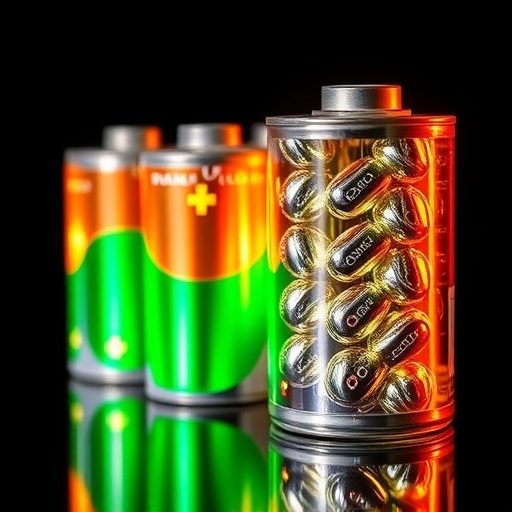The intricate dance of ions within lithium metal batteries has long challenged researchers striving for enhanced performance and longevity. A groundbreaking study led by experts Haoshen Zhou and Shaohua Guo from Nanjing University now illuminates the nuanced roles played by antisolvents within these batteries’ electrolytes, unraveling complexities that have remained elusive until now. By meticulously examining the polarity of antisolvents and its cascading effects on electrochemical phenomena, their research presents transformative insights with profound implications for the next generation of energy storage technologies.
Central to their investigation is the class of localized high-concentration electrolytes (LHCEs), specifically engineered with ester-based solvents and a series of structurally similar trifluorobenzene allotropes serving as antisolvents. These tailored electrolytes provide an ideal platform to dissect the subtle interactions dictated by antisolvent polarity. The team’s systematic approach offers a refined understanding of how antisolvents modulate the solvation architecture surrounding lithium ions, influencing critical interfacial chemistry and deposition dynamics within the battery.
One of the pivotal revelations from this work is the identification of what the researchers term the “drag effect” exerted by antisolvents on the solvation sheath. Contrary to prior models that largely overlooked the nuanced interplay of antisolvent molecules, this research highlights that highly polar antisolvents engage appreciably with the anionic components of the solvation shell rather than interacting directly with the primary solvent molecules. This interaction attenuates the electrostatic binding between lithium cations and their anionic counterparts—a phenomenon that, although subtle at a molecular level, accumulates significantly across repeated charge-discharge cycles, progressively influencing the electrolyte’s overall behavior.
This finding necessitates a revision of the existing micellar solvation structure model, shifting the conceptual framework to a more sophisticated and dynamic interpretation of electrolyte chemistry. Recognizing the antisolvent’s role in ‘fine-tuning’ the ionic microenvironment opens avenues for deliberate modulation of electrolyte properties, thereby coupling molecular design with practical battery performance enhancements.
Beyond solvation dynamics, the study delves into the interfacial chemistry shaped by antisolvent decomposition products during battery operation. The formation of the solid electrolyte interphase (SEI) film—a delicate boundary layer critical for lithium ion transport and electrode protection—is markedly influenced by the polarity of the antisolvent. The research demonstrates that higher polarity antisolvents undergo greater decomposition at the electrode-electrolyte interface, leading to the incorporation of organic moieties into the SEI matrix. Such organic-rich SEI films exhibit diminished ionic conductivity, posing a barrier to efficient ion transport and adversely impacting battery performance.
Importantly, the initial quality of the anion-derived SEI layer at early cycling stages predicates the degree of antisolvent decomposition. This interdependence underscores the need to harmonize the electrolyte composition to foster the formation of thin, robust, and ionically conductive SEI layers essential for long-term battery stability. Through this lens, the polarity of the antisolvent emerges as a crucial, yet previously underappreciated, parameter influencing interfacial layer architecture and functional integrity.
Complementing these electrochemical insights, the team probed the effects of antisolvent adsorption on lithium metal deposition behaviors. Lithium deposition uniformity is paramount, as irregular deposition can precipitate dendrite formation, compromising battery safety and efficacy. The study reveals that highly polar antisolvents, exhibiting hydrophobic interactions with lithium ions, tend to preferentially adsorb onto the lithium metal surface. This adsorption creates local barriers hindering lithium ion mobility, promoting heterogeneous deposition patterns that exacerbate dendritic growth and cycling instability.
This nuanced understanding highlights a delicate balance—while antisolvents are indispensable for modulating electrolyte properties, their excessive polarity or unfavorable adsorption characteristics can undermine lithium metal anode performance. Therefore, optimizing the antisolvent polarity becomes a strategic lever to harmonize interfacial phenomena, ensuring consistent, uniform lithium plating essential for scalable and safe battery technologies.
Leveraging these insights, the research team engineered an optimized ester-based LHCE electrolyte exhibiting finely tuned antisolvent polarity. This electrolyte demonstrated superior compatibility with lithium metal anodes, enabling prolonged full-cell cycling with remarkable stability. Such advancements underscore the transformative potential of rational electrolyte design guided by fundamental structure-activity relationships.
Perhaps most consequentially, this research establishes, for the first time, a direct and mechanistically grounded correlation between antisolvent polarity and three interconnected domains: solvation structure modulation, interfacial chemistry evolution, and lithium deposition behavior. By filling this critical theoretical gap, the study provides a rigorous scientific foundation upon which future electrolyte innovations can be systematically constructed, moving beyond empirical formulation toward predictive design.
In redefining the solvation structure paradigm for LHCEs, the work significantly advances solvation chemistry theory, offering a blueprint for comprehensive exploration of electrolyte molecular architectures. It invites a paradigm shift where molecular polarity is not merely an experimental variable but a targeted design parameter optimized for specific electrochemical outcomes.
This profound investigation into antisolvent roles and mechanisms does not merely enrich academic understanding but holds tangible implications for the commercial viability of lithium metal batteries. By addressing enduring challenges related to SEI formation, ionic transport, and deposition uniformity through molecular-level manipulations, the study propels the field closer to realizing safer, higher-capacity, and longer-lasting batteries.
Taken together, the findings herald a new chapter in energy storage research—one where fundamental chemistry guides engineering innovation, and where intricate molecular orchestrations deliver tangible technological leaps. As demand for advanced batteries escalates across industries—from electric vehicles to grid storage—the insights from Nanjing University’s pioneering work carve a clear path toward sustainable, high-performance energy solutions.
With the future of portable power increasingly dependent on mastering interfacial and solvation phenomena, this groundbreaking elucidation of antisolvent effects invites a wave of targeted research, promising to accelerate the evolution of lithium metal and beyond-lithium battery chemistries worldwide.
Subject of Research: Lithium Metal Batteries, Electrolyte Chemistry, Antisolvent Polarity, Localized High-Concentration Electrolytes (LHCEs)
Article Title: Not Provided
News Publication Date: Not Provided
Web References: http://dx.doi.org/10.1093/nsr/nwaf297
References: Not Provided
Image Credits: ©Science China Press
Keywords
Lithium Metal Batteries, Antisolvent Polarity, Localized High-Concentration Electrolytes, Solvation Structure, Solid Electrolyte Interphase, SEI Formation, Lithium Deposition, Electrolyte Design, Ion Transport, Battery Stability, Ester-Based Electrolytes, Electrochemical Interfaces
Tags: antisolvent drag effectantisolvent polarity influencebattery longevity and performanceelectrochemical phenomena in energy storageenergy storage technology advancementsester-based solvents in batteriesinterfacial chemistry in batterieslithium battery electrolyte engineeringlithium ion solvation architecturelithium metal battery performancelocalized high-concentration electrolytestrifluorobenzene allotropes





